
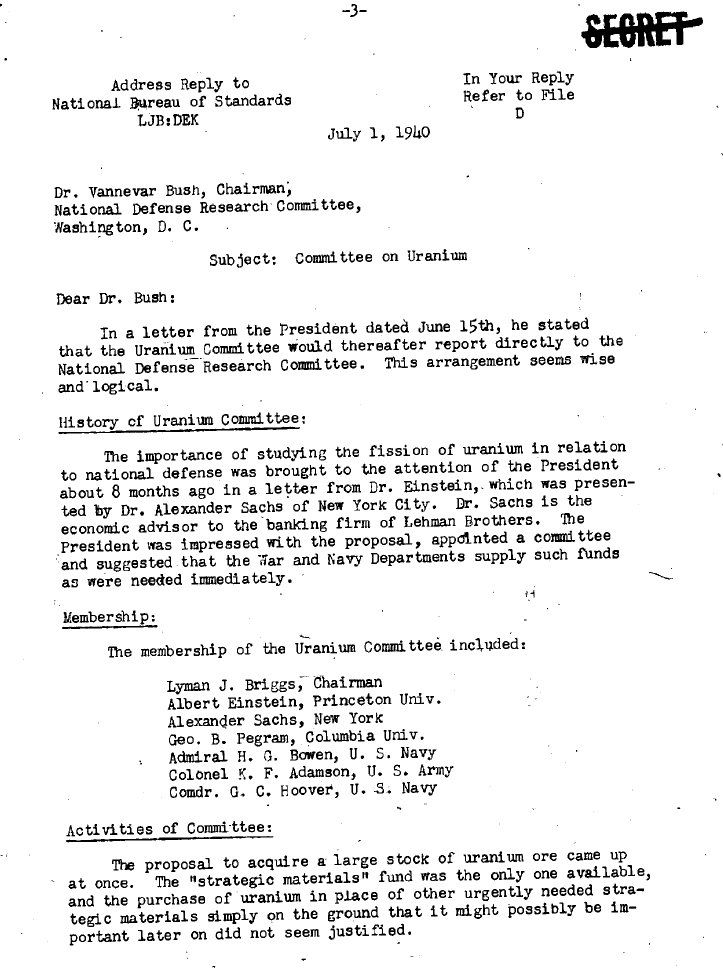

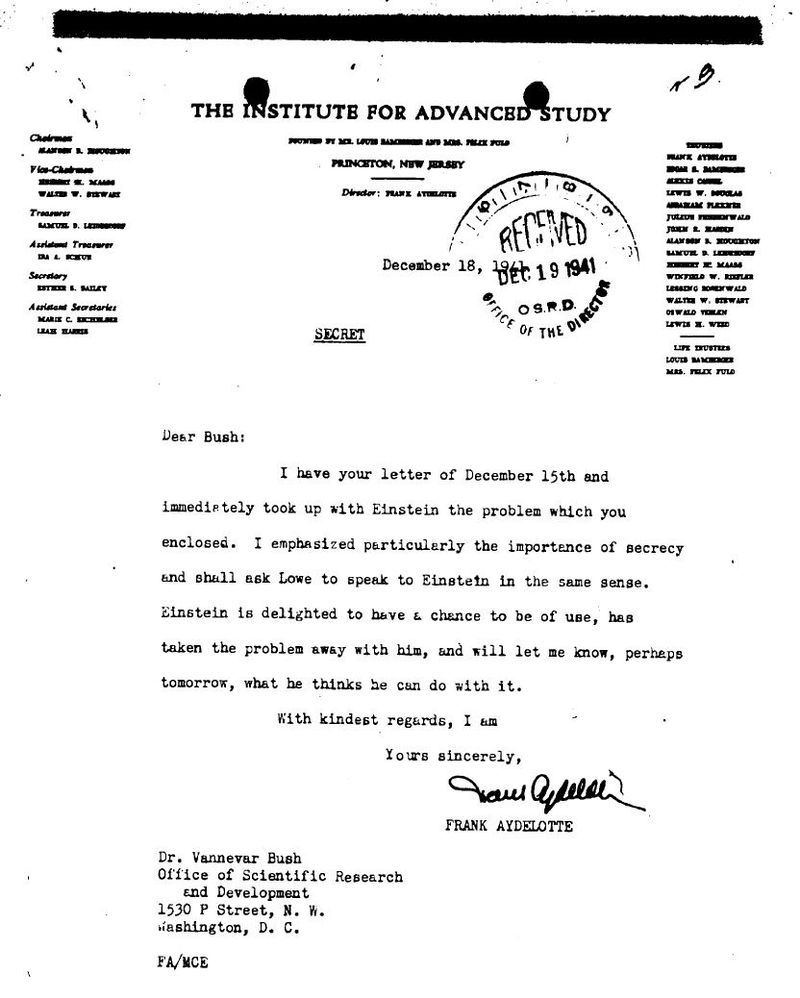

Description
Bush-Conant Files: Atomic Bomb Development, WWII War Office
Timeline of Main Events (1939-1947):
- 1938: Vannevar Bush becomes president of the Carnegie Institution.
- 1939-1947: Timeframe of documents in the Bush-Conant files.
- 1940: Vannevar Bush appointed Chairman of the National Defense Research Committee (NDRC).
- February 1941: James Conant visits England, learns Britain is ahead on nuclear fission research, and worries Germany might be even further ahead.
- 1941:James Conant becomes chairman of NDRC.
- The Office of Scientific Research and Development (OSRD) replaces the NDRC, with Bush as director and Conant as chairman.
- October 9: Vannevar Bush briefs President Roosevelt on the British “Tube Alloys” project and German nuclear efforts. Roosevelt approves and expedites the atomic program.
- May 17, 1941 – June 19, 1942: Conant writes informal history of the S-1 project
- August 1942: OSRD’s role in promoting basic scientific research and development on nuclear fission ends. The program transitions to the Army (Manhattan Project). Bush and Conant continue to oversee the project as chairman and alternate chairman of the Military Policy Committee.
- December 15, 1942: Conant mentions the possibility of Plutonium being a “super-explosive”.
- June 1943: Draft letters to Groves and Oppenheimer from the President to serve as morale boosters for project scientists
- October 20, 1944: Conant to Bush discusses “possibilities of a Super Bomb [i.e., hydrogen bomb]”.
- July 16, 1945: James Conant witnesses the Trinity atomic test at Alamogordo.
- 1945: Bush shares post war thoughts on sharing basic scientific knowledge of atomic energy with the Russians in September.
- Post-WWII (1945-1947): Bush and Conant serve on the Interim Committee advising President Truman on atomic energy policy.
- 1946: Bush and Conant withhold the files as a personal file when the OSRD S-1 Section files were transferred to Oak Ridge.
- 1947:OSRD is disbanded. The Bush-Conant File is transferred to the Atomic Energy Commission (AEC) in a locked safe.
- Sometime later (AEC Move): The locked safe containing the Bush-Conant File is lost and rediscovered under a stairwell. Dr. Richard Hewlett, AEC historian, identifies its contents.
- 1973: The Bush-Conant File is transferred to the National Archives.
Cast of Characters:
- Vannevar Bush: Preeminent American scientist, Vice President of MIT, Dean of the MIT School of Engineering, President of the Carnegie Institution, Chairman of the National Defense Research Committee (NDRC), Director of the Office of Scientific Research and Development (OSRD), Presidential science advisor. Key figure in initiating and overseeing the atomic bomb project.
- James B. Conant: President of Harvard University, Chairman of the National Defense Research Committee (NDRC), Chairman of the OSRD. Managed the development of synthetic rubber and atomic bomb research. Member of the Interim Committee.
- Franklin D. Roosevelt: President of the United States during WWII. Approved and expedited the atomic program after being briefed by Bush.
- Harry S. Truman: President of the United States after Roosevelt’s death. Received advice from the Interim Committee on the use of atomic bombs.
- Frederick Lindemann: Prime Minister Churchill’s chief scientific advisor in Britain.
- Albert Einstein: Renowned physicist. The files contain correspondence about why he wasn’t directly involved in the S-1 project and attempts to obtain theoretical data from him.
- Arthur H. Compton: Physicist, worked on the Manhattan Project. Files contain correspondence about dissatisfaction with the S-1 project felt by some scientists.
- Leo Szilard: Physicist, involved in early research on nuclear chain reactions. Expressed concerns about compartmentalization and patent rights within the S-1 project.
- J. Robert Oppenheimer: Scientific director of the Los Alamos Laboratory, a key component of the Manhattan Project.
- Leslie Groves: Military head of the Manhattan Project.
- Ruth Jenkins: Conant’s secretary at the OSRD, believed to have maintained the “DSM Alphabetical Subject Files” (Section II of the Bush-Conant File).
- Richard Hewlett: AEC Historian who identified the Bush-Conant file after it was rediscovered in the AEC building.
- James P. Baxter III: Historical Advisory Committee Chairman for the AEC, stated the discovery of these documents, “made possible for the first time a satisfactory account of the intricate wartime negotiations with Great Britain and Canada on atomic energy.”
World War II: Office of Scientific Research and Development Atomic Bomb Development Bush-Conant Papers
A collection of 12,700 pages from the Vannevar Bush and James Conant Files concerning the atomic bomb’s development, sourced from the National Archives and Records Administration.
These documents were kept in Dr. James B. Conant’s office for both him and Dr. Vannevar Bush. The files span from 1939 to 1947, with a majority of the documents created between 1940 and 1945.
The contents primarily include letters, memorandums, reports, and technical documents related to the atomic bomb’s development. They feature correspondence from senior government and military leaders as well as prominent American and British scientists and engineers involved in the atomic bomb project. This initiative was initially known by the code names “uranium,” “S-1,” or “tube alloys” (the latter being the British designation) before it was handed over to the army.
The topics covered in the Bush-Conant File encompass scientific and technical challenges; research and development contracts with universities and private companies along with associated financial, personnel, and security issues; collaboration with the British in the Allies’ effort to develop nuclear weapons ahead of the Germans; legislation and strategies for postwar atomic energy development and regulation; and official government policies.
The Bush-Conant Files illustrate the OSRD’s involvement in fostering fundamental scientific research and development on nuclear fission prior to August 1942. Additionally, they record Bush and Conant’s ongoing responsibilities as chairman and alternate chairman of the Military Policy Committee, overseeing the army’s atomic bomb development during World War II, and as members of the brief Interim Committee, offering advice on foreign relations and domestic laws regarding atomic energy regulation right after the war. The collection contains finding aids that feature an Annotated Folder Title List (Appendix A), an index (Appendix B), and a Folder Contents List. The National Archives compiled the Annotated Folder Title List and the index. The Historian’s Office of the Atomic Energy Commission created the Folder Contents List when the records were sent to the National Archives. This list categorizes memorandums and letters by sender, recipient, and date.
The disc features a text transcript of all computer-readable text integrated into the graphic images of each document page, serving as a searchable resource. Users can perform text searches across all files on the disc.
Vannevar Bush was one of the leading American scientists during the early to mid-20th century. By 1938, Bush had founded what is now Raytheon, developed an analog computer with some digital elements capable of solving differential equations, served as Vice President and Dean of the MIT School of Engineering, been appointed to the National Advisory Committee for Aeronautics, and become president of the Carnegie Institution, the top science foundation in America at that time.
In 1940, Vannevar Bush was named Chairman of the National Defense Research Committee (NDRC) and became Director of the Office of Scientific Research and Development (OSRD) in 1941. He oversaw the efforts of more than six thousand scientists who were focused on applying science to military purposes. As the leader of OSRD, he acted as a science advisor to Presidents Roosevelt and Truman. Bush launched an urgent initiative to develop an atomic bomb, which ultimately led to the Manhattan Project, ensuring it received high priority. James Conant, who served as Harvard’s president, was invited by Vannevar Bush, the then director of the Carnegie Institution of Washington, to be part of the newly established National Defense Research Committee (NDRC), where he became chairman in 1941. The NDRC’s goal was to organize, oversee, and carry out scientific research related to the challenges of developing, manufacturing, and utilizing warfare technologies. In 1941, the NDRC was succeeded by the Office of Scientific Research and Development, with Conant continuing as chairman and Bush serving as director.
Conant oversaw the advancement of synthetic rubber and the atomic bomb research that eventually evolved into the Manhattan Project. He attended the Trinity atomic test at the Alamogordo Bombing and Gunnery Range on July 16, 1945. Additionally, he was part of the Interim Committee that provided advice to President Truman regarding the deployment of atomic bombs on Japan.
In February 1941, Conant traveled to England to confer with his British colleagues. There, he discovered from Frederick Lindemann, Chief Scientific Advisor to Prime Minister Churchill, that Britain was significantly ahead of the United States in nuclear fission development. This was largely because British scientists were convinced of the viability of atomic weapons. Conant was concerned that Germany might be even further advanced due to its strong reputation in nuclear physics.
On October 9, 1941, Vannevar Bush met with President Roosevelt to brief him on Tube Alloys, the British atomic bomb initiative, as well as the work of the Maud Committee on atomic bomb development and the largely unknown German nuclear energy project. Roosevelt quickly approved and accelerated the atomic program. In 1946, Bush and Conant kept these documents as a personal file when the OSRD S-1 Section records were moved to Oak Ridge. When the OSRD was dissolved in 1947, the Bush-Conant File was placed in a locked safe and sent to the Atomic Energy Commission (AEC). This safe went missing during the AEC’s relocation to Germantown but was found years later beneath a stairwell in one of their buildings. When an AEC records officer discovered the locked safe, its origins and contents were unknown. Dr. Richard Hewlett, the historian for the AEC, was asked to observe its opening by a locksmith hired for that task. Hewlett reported that the first item retrieved from the file was a letter signed by Franklin D. Roosevelt. James P. Baxter, III, who was then the Chairman of the AEC Historical Advisory Committee, stated that the retrieval of these documents allowed for a comprehensive account of the complex wartime discussions regarding atomic energy with Great Britain and Canada.
The Bush-Conant File was sent to the National Archives in 1973, along with additional S-1 files from the OSRD, which included correspondence and technical reports related to the atomic bomb’s development.
The Bush-Conant File is composed of more than 240 folders divided into two sections. Section I, titled “Subject Files,” includes folders 1-22 organized under four main categories: Historical Overview of S-1 Program, 1939-45 (folders 1-7); U.S.-British Relations on Nuclear Energy, 1942-45 (folders 8-12); OSRD S-1 Program Administration, 1941-45 (folders 13-21); and Material Relating to a National Research Foundation, 1945 (folder 22). Section II, labeled “DSM [Development of Substitute Materials] Alphabetical Subject Files,” contains subject files arranged in alphabetical order, as indicated by the title. It is thought that Section I contains files created by Conant for his personal reference, while the files in Section II were kept in Conant’s OSRD office by his secretary, Ruth Jenkins. The documents in Section I provide a comprehensive historical account of the atomic bomb project’s development. Folders 1 and 2 include a two-part manuscript detailing the S-1 Project’s history, authored by Conant, spanning from May 17, 1941, to June 19, 1942. These folders also contain documents referenced in his notes. Folder 3 holds documents that Conant intended to use for a history of the OSRD, a task he never completed.
Key points include:
Correspondence regarding Albert Einstein and the reasons for his exclusion from the S-1 project, along with two attempts to secure theoretical data from him without revealing its purpose.
Documents collected to support Conant’s informal account of the S-1 (A-bomb) project, from May 17, 1941, to June 19, 1942. This includes typewritten and handwritten versions of Conant’s informal history and his handwritten lists of significant documents, as well as copies of three 1941 National Academy of Sciences reports assessing the feasibility of creating an atomic bomb.
Memorandums and letters exchanged between Vannevar Bush and Franklin D. Roosevelt; materials addressed to Bush or Arthur H. Compton reflecting some scientists’ dissatisfaction with the S-1 project; letters from Leo Szilard voicing concerns about the compartmentalization policy adopted by project managers and his potential patent rights. Correspondence informing the British about the U.S. uranium program’s reorganization in December 1941, alongside British communications detailing their “Tube Alloys” program’s structure. Summaries of reports detailing intelligence findings on Germany’s attempts to create an atomic bomb (refer to folders 7, 75, and 230) and a memorandum from September 25, 1945, that outlines Bush’s reflections on sharing fundamental scientific knowledge regarding atomic energy with the Soviet Union.
A memorandum dated October 20, 1944, from Conant to Bush discussing the potential for a “Super Bomb” (hydrogen bomb), along with a December 15, 1942, memorandum from Conant to Bush regarding the possibility that plutonium could be a “super-explosive.”
A previously classified file containing materials related to Bush, mainly consisting of memorandums from Bush to Conant about the global implications of the atomic bomb, biological warfare, Conant’s firsthand account of the Trinity Test, and draft letters from June 1943 intended to boost the morale of project scientists, addressed to Groves and Oppenheimer from the President.
A letter from A. H. Compton to J. B. Conant discussing the Chicago Radiation Laboratory’s strategies for safeguarding its staff’s health and plans for additional research into radiation dangers.
Correspondence related to the recruitment of scientists sought by J. Robert Oppenheimer for the Los Alamos Project, Bush’s inquiry about who was privy to the ultimate goals of Oppenheimer’s role, and a copy of the War Department’s security notice from May 13, 1942, regarding Oppenheimer.
Related products
-
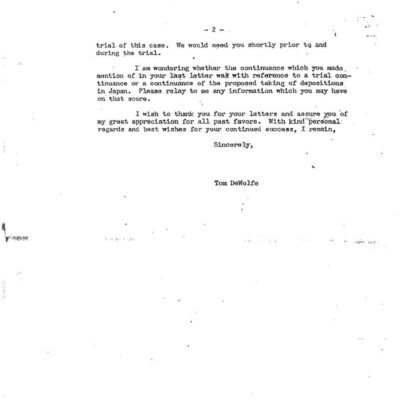
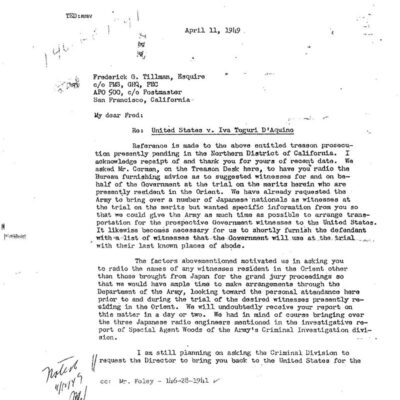
Tokyo Rose: Department of Justice Prosecution Files
$19.50 Add to Cart -
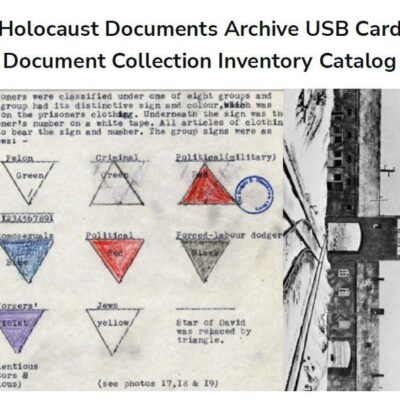
Holocaust Document Archive PDF file – Inventory Catalog of Document Collection
$3.94 Add to Cart -
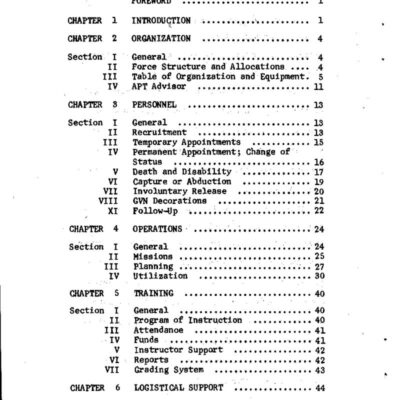
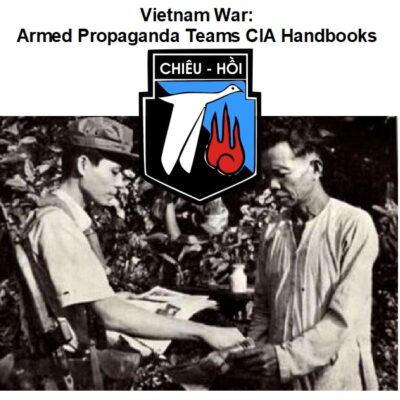
Vietnam War: Armed Propaganda Teams CIA Handbooks
$1.99 Add to Cart -
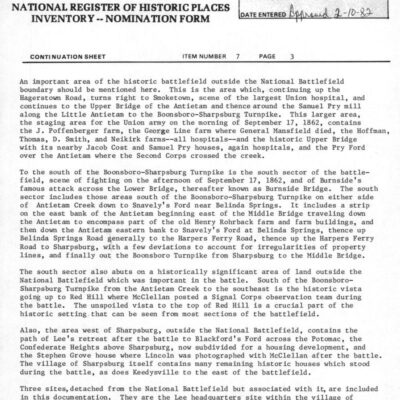
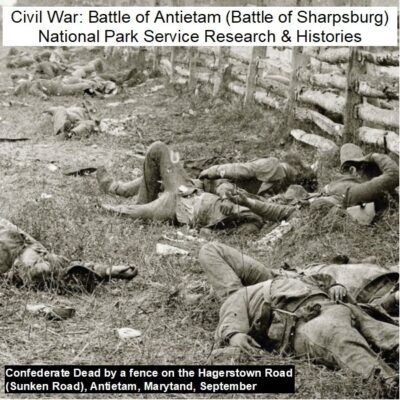
Civil War: Battle of Antietam (Sharpsburg) – National Park Service Archives
$9.99 Add to Cart